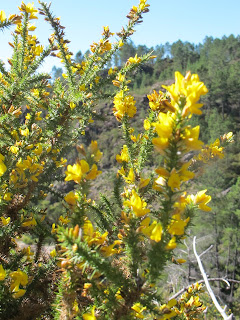The Gorse is a thorny shrub belonging to the same family as peas. The thorns are intended to dissuade herbivores from eating the plant. Those animals, in turn, target the young branches, which are less woody and therefore hurt less to eat.
This species is nitrogen-fixing, therefore turning soil more rich in nitrogen (vital for its fertility!). People used to burn them and spread their ash in agricultural fields.
This is a species that regrows easily from fire and it's considered to be important in regenerating the soils and ecosystems after disturbance, in what's know as ecological succession.
During the hottest months of summer, you can hear small cracking sounds when you're close to these bushes. It is the pods cracking under the heat, releasing the seeds into the air.













